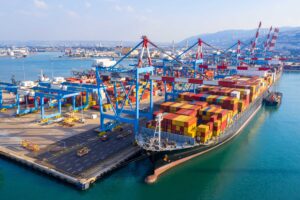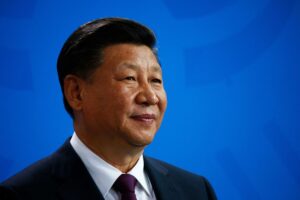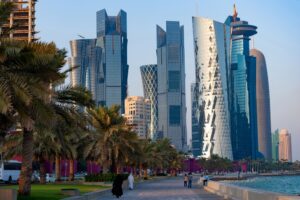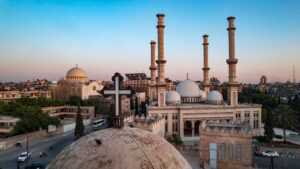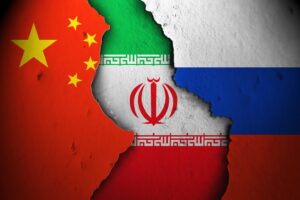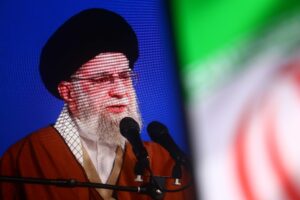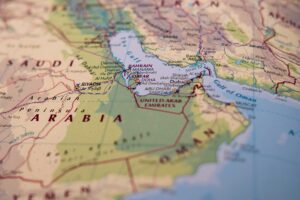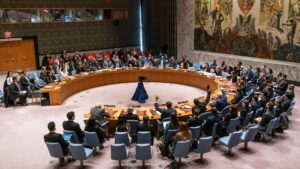The starting point to try and answer this question is to identify what a post-COVID economy might look like for the Gulf countries[i]. In turn this requires a discussion of the energy transition that began before the pandemic. There is a long history of energy transitions. This is when an economy switches from one major source of energy to another[ii]. The current energy transition is a move away from hydrocarbons supplied by oil, gas and coal to electrons supplied by wind and solar power. It was triggered by environmental concerns. Initially, these revolved around climate change and the need to reduce carbon emissions. More recently, notably in Asia there has also been growing concern about particulate emissions from burning hydrocarbons causing poor urban air quality. As with other energy transitions, once the trigger has been pulled, other reinforcing factors come into play speeding up the transition. These are usually associated with developments in technology leading to changes in relative energy prices. In this case, a key reinforcing factor has been the dramatic fall in the cost of renewable energy.
The main issue of contention and debate regarding the current transition is its speed and depth. In the view of this author, the ‘Energy Establishment’[iii], which refers to institutions such as the International Energy Agency (IEA), the OPEC Secretariat, The US Energy Information Administration etc. and major international oil companies (IOCs), has been consistently underestimating its speed. This is the result of a combination of vested interest and intellectual inertia. The evidence for this is their constant and consistent underestimation of the penetration of renewables energy. There has been a strong tendency for them to argue that energy transitions are slow. In some cases that has been true. For example, the transition in the United States between 1860 and 1900 from wood to coal took 40 years. However, more recently transitions have been much faster. For example, in France the switch from coal and oil to nuclear took only ten years between 1974 and 1984 while in the UK, the switch from coal to renewables took only eight years between 2010 and 2017. This has been specially true when governments, for whatever reason, have played a large role in the process.
This debate regarding the speed of the transition has been further aggravated recently by the COVID pandemic. This pandemic led to a dramatic fall in fossil fuel consumption. The IEA[iv] has estimated that in 2020 global coal demand is expected to fall by about 8%, the largest drop since World War II. Oil demand will fall by 8.8 mb/d and gas consumption is expected to fall by 4%. Meanwhile, renewable electricity has been largely unaffected.
Many of the changes in behaviour in 2020 leading to lower demand for hydrocarbons are likely to continue long after the pandemic is deemed to be over.
As to the future, some argue the pandemic may slow the transition because governments will be distracted from climate change issues by the economic crisis and unemployment created by successive lockdowns. By contrast, others argue that the greater involvement by governments in the economy because of the pandemic is likely to increase intervention to reduce carbon emissions thereby speeding the transition. On balance, this author agrees with the opinion that the pandemic has increased the speed. Many of the changes in behaviour in 2020 leading to lower demand for hydrocarbons are likely to continue long after the pandemic is deemed to be over. For example, 60 percent of liquid fuels demand is accounted for by travel, which is likely to reduce following changes to working practices. The implication is that global oil demand has probably reached a peak[v]. Thus a post-COVID economy will be one facing declining oil demand.
This obviously has serious implication for the GCC since all of its members are extremely dependent on oil both for government revenue and exports[vi]. Furthermore, despite much rhetoric over the decades, they have failed abysmally to diversify their economies away from oil. Economic diversification in the GCC countries began to be an issue for discussion following the first oil price shock of 1973-4. However, economic diversification for oil producers is complex and difficult. The starting point is the necessity to understand that oil revenue for an economy is not income. It is simply a reshuffling of the nation’s portfolio of assets. Thus one asset in the portfolio is oil below the ground. When it is produced and sold, it has been swapped for another asset i.e. currency.
However, oil is a depletable resource. It is depleted either because the oil reserves decline naturally or because the demand for the oil disappears as other energy forms replace it, as is the case in an energy transition. As the late Zaki Yamani once famously said – “the stone age did not end because we ran out of stones!” Therefore, it is essential that the currency be used to create alternative income earning assets. Otherwise the national economy is not sustainable. This is what economic diversification means and why it is essential. Thus as the ability of oil to generate revenue declines, other income creating assets must be created instead. One means of measuring such diversification is to measure the non-hydrocarbon fiscal deficit (NHFD) and the non-hydrocarbon current account deficit (NHCAD). These simply measure how far the budget deficit and current account deficit in the non–hydrocarbon sector requires a surplus in the hydrocarbon sector to cover them. A fully diversified hydrocarbon economy is where both deficits are zero. If diversification is measured by the non-hydrocarbon fiscal deficit (NHFD), after the 1990s, GCC economies became more oil dependent. In the 1990s, Saudi Arabia’s NHFD was below 50 percent of GDP; by 2010 it was 140%. This was similar in the rest of the GCC. Using a different metric to measure diversification, in 2011, the IMF found non-hydrocarbon GDP in the GCC was 61% of GDP in 1990. By 2010, this had fallen to 51%[vii].
The GCC and its rulers have always had problems understanding this context. Since the first oil shock of 1973, there has been much rhetoric about the need to diversify the GCC economies. For the most part this tended to occur following periods of lower oil prices. Thus following the oil price collapses of 1986, 1998, and 2014 economic diversification moved rapidly up the GCC Governments’ policy agenda. However, when the oil price recovered, efforts weakened and diversification failed to progress. The attitude was epitomized by the view that “we have the oil reserves and so the consumers will have to come to us”. A world of declining oil demand was never envisaged.
A diversified economy requires a dynamic private sector to make the investments and create the income earning enterprises. In the GCC, the ruling elites for the most part have stifled their private sectors.
It is important to try and understand the causes for this failure to diversify given other oil and gas producers such as Norway and Malaysia have successfully diversified which proves it can be done. It is a complicated story to explain this GCC failure with many social, economic and political dimensions. However, the central explanation lies in the nature of the political economy, the rule of law and the behaviour of the ruling elites. A diversified economy requires a dynamic private sector to make the investments and create the income earning enterprises. In the GCC, the ruling elites for the most part have stifled their private sectors. Put crudely, they grabbed all the best commercial opportunities for themselves. This was often compounded because of extremely weak property rights and a limited rule of law. Entrepreneurs outside of the ruling elites were extremely vulnerable to those elites. A classic recent example was the events in November 2017 when some 400 prominent Saudis were ‘arrested’ and imprisoned in the Ritz Carlton hotel in Riyadh and held there until they paid ‘fines’ to be released. It was alleged they were all involved in corruption. While that may well have been the case, the legal basis for the ‘arrests’ and the ‘fines’ was never clarified. Thus while the GCC countries do have elements of vibrant private enterprises, for the most part, they tend to operate outside their own countries where they can depend upon legal protection from arbitrary interference by their own governments.
Thus to answer the original question about whether the Gulf States are preparing for a post-COVID economic world the short answer is no although the longer answer is more complex. As the energy transition speeds up, oil demand will fall. Thus the oil markets become more competitive. At the very least this will lead to lower oil prices, which makes it more difficult for oil producers to maintain their support for the non-hydrocarbon element of their economies as the NHFD rises. The only counter argument to this is if the collapse in upstream investment in 2020 as the result of the oil price collapse reduces producing capacity thereby tightening the market. Tight markets are vulnerable to political disruptions and possible price spikes. However, this would require a significant recovery in oil demand therefore a continued weakening market is the more realistic option.
However, in a weakening market not all oil producers will suffer equally. As oil demand declines, oil consumers will seek lower cost oil. This will give the GCC producers a significant advantage over other higher cost producers. They are low cost relative to most other producers simply because their fields are larger and more productive. This means they will be able to produce for longer although, because of price competition, their revenues are likely to be falling. Nonetheless, they will be able to survive for longer than most other producers. Obviously oil demand is never likely to completely disappear. For some uses such as long distance flying oil will remain important. There is also using oil as a feedstock for petrochemicals although these are also facing environmental concerns over plastic pollution. In addition to being low cost producers, some of the GCC producers will have another market advantage to extend their lives as oil producers. Concerns over climate change and carbon emissions mean that oil consumers, as well as seeking cheaper oil, will also be seeking cleaner oil in the context of both production and burning. This will require significant changes in technology. Saudi Arabia, Abu Dhabi and Qatar have all been investing heavily in trying to develop cleaner oil technology covering such areas as carbon capture and storage and reduced methane leakages to name but two. In so far as this investment in low carbon technology produces positive results, this might also further extend their life as oil producers giving them more time to diversify their economies. Precisely how much time can be bought depends largely on the speed of the energy transition and how rapidly oil demand falls following the pandemic.
However, this is fiddling around the edges. Ultimately, the only realistic solution to the existential threat the GCC faces as a result of the current energy transition is to diversify their economies away from continuing oil dependence. This requires fundamental and deep political reform to guarantee property rights and unleash the undoubted significant talents of their populations. Without this, the countries face serious threats to their continued stability. Given the underlying causes of the Arab Spring that broke out in 2011 – notably concern over corruption and frustrated expectations – have not properly been addressed anywhere in the region, the prospects look bleak.
[i] These are defined for this paper as the Gulf Cooperation Council countries (GCC), which are Bahrain, Kuwait, Qatar, Oman, Saudi Arabia and the United Arab Emirates.
[ii] Stevens, P. The Geopolitical Implications of Future Oil Demand. Research Paper, Chatham House, August 2019, https://www.chathamhouse.org/2019/08/geopolitical-implications-future-oil-demand. (Accessed, 1 March 2021)
[iii] The ‘energy establishment’ refers to institutions such as the International Energy Agency (IEA), the OPEC Secretariat, The US Energy Information Administration etc. and the major international oil companies (IOCs).
[iv] IEA COVID-19 Exploring the impacts of the Covid-19 pandemic on global energy markets, energy resilience, and climate change. https://www.iea.org/topics/covid-19 (Accessed, 1 March 2021)
[v] This is a view which was recently confirmed by BP in its latest view of the future of energy
https://www.bp.com/en/global/corporate/energy-economics/energy-outlook.html (Accessed 28 February 2021)
[vi] The Future of Oil and Fiscal Sustainability in the GCC Region. Tokhir Mirzoev, Ling Zhu, Yang Yang, Andrea Pescatori, and Akito Matsumoto : supervised by Tim Callen. IMF Middle East and Central Asia Department Research Department No. 20/01, 2020, https://www.imf.org/en/Publications/Departmental-Papers-Policy-Papers/Issues/2020/01/31/The-Future-of-Oil-and-Fiscal-Sustainability-in-the-GCC-Region-48934 (Accessed 28 February 2021)
[vii] Stevens, P. The role of foreign investment in resource-rich regions: the Case of the Gulf Cooperation Council. The Baker Institute for Public Policy. Working Paper. February 2020


